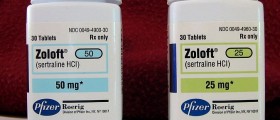
Ciprofloxacin is an antibiotic which belongs to a group of fluoroquinolones. As any other medication Ciprofloxacin possesses a variety of side effects. Some people may experience none of these. However there are people who had to deal with serious side effect of this drug. All side effects can be roughly divided into general and local. As for general side effects most common and not so severe ones include nausea, vomiting, and change in stool (diarrhea). Abdominal pain happens on rare occasions. Gastrointestinal disturbances are usual for majority of antibiotics. The doctor recommends to a patient to use probiotics together with antibiotics as probiotics tend to maintain the bacterial flora normal and reduce the chance of digestive side effects. The most severe GI side effects includes bleeding, ileus, intestinal perforation, pancreatitis and pseudomembranous colitis. Fortunately these are rare complications.
Skin rash may develop in a form of pruritus, skin candidiasis, urticaria, cutaneous vasculitis, hyperpigmentation and photosensitivity. Photosensitivity can be avoided if one stays away from the sun during the treatment. Anaphylactic reactions may develop in patients with HIV.
Neurological side effects include headache, dizziness, ataxia and tremor. Patients may feel restless, agitated and irritated. Peripheral neuropathy is connected to Ciprofloxacin as well as seizures and grand mal convulsions. Still the seizures are more usual if the drug is combined with other medications. Rare side effects include benign intracranial hypertension, confusion and problems with sensations and movements.
Local side effects may affect kidneys, liver, muscles and bones, heart, blood and metabolism in general.
Kidneys may be affected by allergic interstitial nephritis. This severe condition is treated with corticosteroids. However, there is slightest increase of creatinine and uric acid levels in blood. Renal failure and other forms of nephritis are not so common.
Liver may be reversibly damaged so the jaundice and increased levels of liver enzymes occur. Severe cases includes hepatic necrosis and hepatic failure.
As for musculoskeletal system the most common side effects includes pain in joints, stiffness of joints, muscle spasms. Tendon rupture is serious side effect which needs surgical treatment.
The heart conditions such as angina and heart attack may be exacerbated by Ciprofloxacin. Arrhythmias, cardiopulmonary arrest, increased blood clotting and changes in blood pressure may be present as well.
Hematologic side effects feature with lympadenomegaly and even petechiae which are purple spots on the skin caused by bleeding within the skin. Increased or reduced number of all blood cells occurs in some cases. Bone marrow depression, fatal pancytopenia and hemolytic anemia are most serious conditions.
Metabolic side effects may reflect in increased levels of certain minerals and elements such as calcium. Even some enzymes (amylase, lipase etc.) may be increased as well. Ciprofloxacin belongs to a group of antibiotics which may lead to low blood sugar levels.
Apart from the previously mentioned side effects the person may experience high temperature, ringing in ears, changes in taste and smell, and develop additional fungal infection.

















Your thoughts on this
Loading...